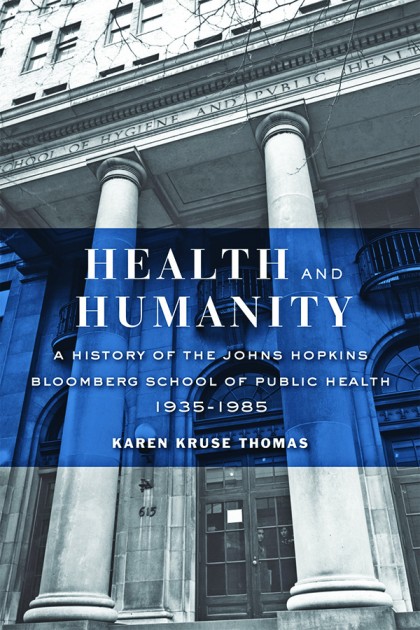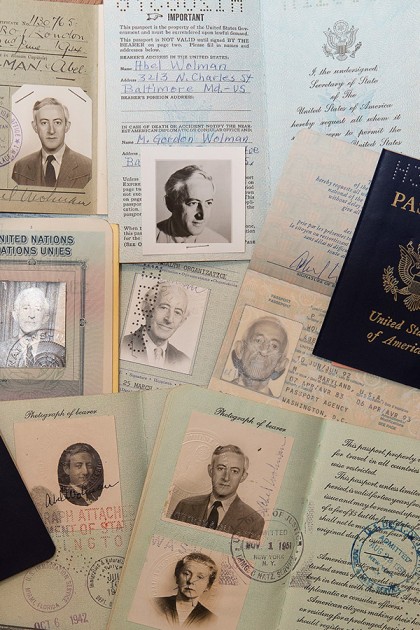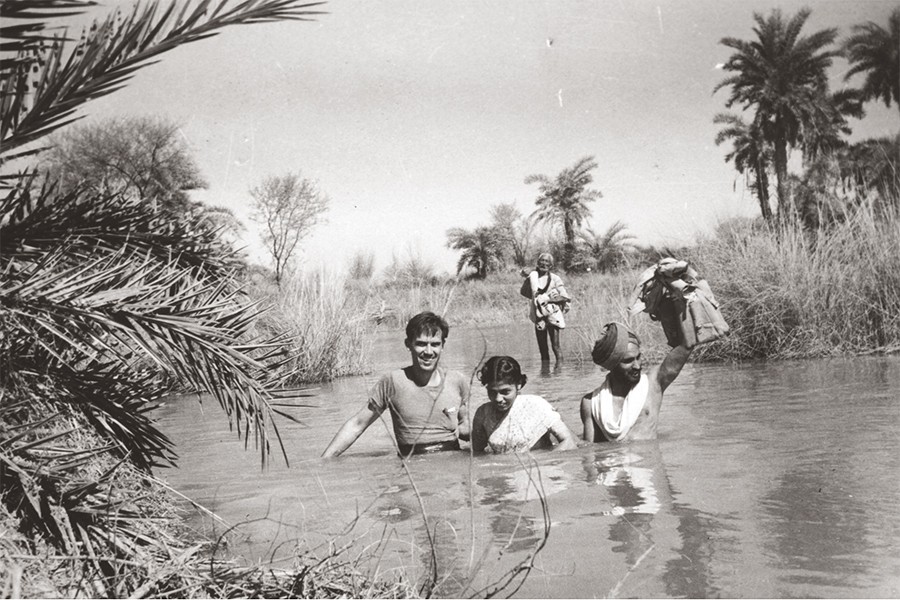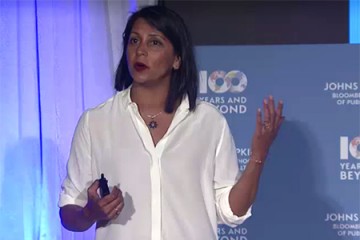In war, humans inevitably fashion novel ways to annihilate one another. But out of conflict, so too often come new methods and measures to preserve life. During World War II, the U.S. government mobilized an army of health professionals to protect both military and civilian populations from deadly agents such as poison gas, malaria, syphilis, and the dawn of weapons of mass destruction.

The oddest of bedfellows, public health scientists and the military, not coincidently share a common parlance—both wage campaigns, check logistics, and deploy units on the front lines.
In her new book Health and Humanity: A History of the Johns Hopkins Bloomberg School of Public Health, 1935-1985 (Johns Hopkins University Press), historian Karen Kruse Thomas examines this intersection of war and public health, and how it triggered a scientific research boom that developed evidence and practical measures to prevent death on an unprecedented scale.
The book, commissioned to honor the Bloomberg School's 100th anniversary, offers an in-depth account of the transformative years of the world's oldest and largest independent school of public health and the growth of academic public health in the United States. Thomas chronicles how the school—originally known as the Johns Hopkins School of Hygiene and Public Health—transformed from a small, private institute devoted to doctoral training and tropical disease research to a leading global educator and innovator in fields from biostatistics to mental health.
At its heart, Health and Humanity examines the influence of politics, federal funding, and worldwide conflicts on not only the mission of the school but the creation of such massive health institutions as the Centers for Disease Control, World Heath Organization, and USAID. It also probes into the school's byzantine relationship with Baltimore and its Southern roots.
Thomas, a staff historian of the Bloomberg School of Public Health and author of Deluxe Jim Crow: Civil Rights and American Health Policy, 1935–1954, dug deep into archives and conducted nearly 60 oral histories to research this comprehensive story.
The Hub sat down with Thomas to talk about the school's legacy and its evolution from wartime school to institution doing battle with chronic and communicable diseases worldwide.
Few things ever follow a straight line. How did the final product differ from what you originally set out to do?
I was hired in 2008 as a postdoctoral fellow, specifically to research and write the history of the school. It was supposed to be the follow-up to Elizabeth Fee's book Disease and Discovery, which is one of the most highly cited and read books in public health. So it was a daunting challenge. She took the history [of the school] up to 1939. I was originally supposed to go from 1939 up until 2001, when the name of the school changed. But as I got into the research, I realized the work was going to be a lot harder in that in more recent periods, people hadn't deposited their records yet. Plus, the people I'd be writing about were still walking around these halls.
I suggested we end at 1985, and I took the history back to 1935 to get a nice half-century. And 1935 was the year of the first federal funding for public health through the Social Security Act. I'm a policy historian, and like any good journalist, I follow the money. Federal funding absolutely transformed the school and the entire university. Johns Hopkins' proximity to Washington, D.C., and its involvement in World War II in a wide variety of military and other defense projects made Johns Hopkins what it is today. I looked at how different federal projects in the military and public health service, and later in the State Department, interacted with the school's development. It helped create things like the first Department of International Health and the first Department of Mental Health.
The school was also very much a creature of Baltimore. Another big thread in the book became how the School of Hygiene shaped East Baltimore and how East Baltimore shaped the school.
You took on the years 1935 to 1985, but how much of the founding of the school is in here? The book helps celebrate the school's 100th anniversary, so you must have been tempted to go back to 1916 where it all started.
I give a recap of Elizabeth Fee's book in the prologue, and I summarize a few points, like how the school's original name was the School of Hygiene and Public Health, inspired by German institutions. Fee felt that science and the hygiene part were somewhat at odds with the community public health aspects. I make the case that those two sides of the school were fairly well integrated as you go forward in time, and the people who were for strong scientific research were also the very same people active on the front lines of public health. William Welch, the school's first dean, himself chaired the board of the Maryland Department of Health and was heavily involved in the mental hygiene movement. He was doing all these traditional public health things, in addition to his long-standing role as the father of American medicine.
Do you see this work as very much a sequel to Elizabeth Fee's book, and did that influence the ground you covered?
Yes, it was definitely a sequel. For example, she had written about the Eastern Health District, which was begun in 1932 [by the Baltimore City Health Department and the School of Hygiene and Public Health]. I took that story and brought it to the 1950s. It's a complex story because tensions between the school and the city's health department really intensified after World War II. I talk about why that happened, and how the EHD was a model worldwide for research and training in public health and community health.

Image caption: Aviation medicine residents observe and experience the physiological effects of Arctic flight conditions at the U.S. Air Force School of Aviation Medicine at Randolph Field, Texas in 1952. Johns Hopkins was among the three schools of public health selected to provide the first year of training for the two-year aviation medicine residency program established in 1950.
Image credit: U.S. Air Force Office of History
What informed the structure of the book and drove the narrative? Was it the original intent to go by topic or chronologically?
(Laughs) I rewrote the manuscript probably at least three times. I'm a historian and researcher, so getting all my footnotes right is one side of it, but then writing a very readable and engaging narrative history that centered around people is also part of it. Then you have to balance the stories of the school, the university, Baltimore, and federal public health policy. Not to mention the story of other schools of public health that were being founded, and the growth of academic public health and global health. Balancing all this was extremely challenging. In one iteration of the book, I focused a lot on the school during WWII and the Cold War and made that a main theme of the book. But then I decided to bring in the more local story. I went back and changed it.
To come back to your question, the book is organized somewhat chronologically, but one of its main sections focuses on the school's Southern roots, and how important it is that it was founded in Baltimore. There was a competition where the Rockefeller Foundation could have awarded its grant to found the first school of public health at Harvard, or the University of Pennsylvania, or Yale, but they decided to award it here, one because of William Welch, and two because we were in Baltimore and we had the 'more interesting diseases' here: we were more tropical, a port city, and farther south. And the Rockefeller Foundation was very oriented toward Latin America and the Caribbean.
Like I said before, war was another unifying theme. There was a nickname for the school early on, the West Point of public health, and so the second chapter is about the school during World War II, and how the war brought this very southward-looking, regional institution to becoming a very national and international one that influenced the creation of the CDC, NIH, the World Health Organization. All of these bedrock organizations we know today came out of that time period, and the school was very intimately involved in that.
In the years you cover, do you feel that the masses—the general person-on-the-street—really understood the mission of public health and the school's mission?
No, and I talk about that. Even back to the school's original name, School of Hygiene and Public Health, I point out in the book that our degree names were such that we had a doctor of science in hygiene, a master of science in hygiene. Those were the science degrees, and then we had a master's degree and doctoral degree in public health, which were the practice/professional degrees. But by the 1950s, the term hygiene had a negative connotation. It was associated with, for example, dental hygiene, such as brushing your teeth. And so the school's leadership removed the word hygiene from the degree name so it was just doctor of science.
Public health was founded on what was called the basic six services: statistics, maternal and child health, sanitation, disease control, public health laboratories, and education. Public health leadership were very, very careful to not step on the toes of private physicians. They never provided any type of treatment or clinical care. That was absolutely off limits. But as time goes on, a big part of what the school did was start founding all these programs that directly involved treatment and clinical care, and one of the very first ones was the Venereal Disease Control Program, because you couldn't prevent syphilis without also treating the people infected. So, that kind of crossed the line, and then you get disagreements between organized medicine, the surgeon general and public health officials over national health insurance and what role public health should play in things like the organization of hospitals. The scope of public health really expands tremendously during the period that I'm writing about.
Today, the Bloomberg School has projects throughout the globe and it's focused on saving millions at a time. Was that always the case?
The school was very much shaped by the original patron, the Rockefeller Foundation. The school was founded at least in part as a training ground for Rockefeller Foundation International Health Division officers. These people went to China and Latin America, and Latin American physicians would come to the school to spend a year here and go back and maybe become minister of health of their nation. A lot of the first schools of public health in South America were founded by our graduates. So, yes, from the very beginning about a quarter to a third of the student body were from foreign countries. That has always been a big piece of our mission and identity.

Image caption: The many passports belonging to Johns Hopkins graduate and longtime professor Abel Wolman
Image credit: Special Collections, The Johns Hopkins University
One of the most interesting things in the book, in my opinion, was then why in the late 1950s and early 1960s we really shift our focus dramatically due to world political events. We shift from Latin America to south Asia because India, for example, was neither aligned with the Soviet Union nor the United States. And when USAID was created in 1961, the Kennedy administration and later the Johnson administration wanted to focus a lot of the foreign aid money on health. Our Department of International Health was actually created as the research and training arm of the USAID. We sent a lot of our students and faculty to India and Pakistan in the early 1960s, and that was a significant geographical shift in what we do.
I'm curious—you're writing about public health and medicine as it was decades ago. Did many aspects of care surprise you and seem way out of step with what we now know and practice here in 2016? As any historian, you have the luxury of hindsight.
Here is how I would answer that: There were different priorities back then. For example, in the 1940s, when millions of people were dying from malaria, the school was directly involved with the introduction of the insecticide DDT and vector control methods for insect-borne diseases. Many of the top global leaders who ran the malaria campaign for the World Health Organization were from Johns Hopkins, and one was Fred Soper.
Soper estimated in 1948 that if we're willing to put the money in, we could eradicate malaria in 10 years because DDT is so powerful. We can completely wipe out a disease for the first time ever. He was very optimistic. You could certainly argue it was very important and worthwhile to save all these peoples' lives, and he was in fact successful. He dramatically improved the survival rate of people in the military during WWII and the citizens in the areas that had malaria. There was still malaria in Italy, North Africa, and even the American South during that period. That is a good goal, but we find out later that DDT is a very toxic chemical that causes cancer and gets into the environment. So one of the ironies is that when we get to 1966, not only are we not using DDT anymore, but one of the School of Public Health faculty, William Sladen, does research on Antarctic penguins and seals and publishes a landmark article that says DDT has gotten so far into the ecosystem, that it's in the blood of these penguins and seals. And that, along with Rachel Carson's Silent Spring, is a major turning point. There is a federal ban on DDT.
Bring that to the present. What if DDT or something like it could help us fight the Zika virus? What's the risk and what is the benefit? There were some things that were just a very bad idea and we should never have done them, but also a lot of things you can look back and say in the context of the time, and given the calculation they were using, made sense.
On perhaps the opposite side of the coin, what did you turn up in your research that showed how forward-thinking the school was on something?
I'll give you one example. We established the first academic unit that focused on mental illness as a public health issue, the Department of Mental Hygiene. And I'll pause here to give my short cocktail napkin definition of public health, which is two words: prevention and population. Instead of waiting to treat diseases after people are already sick, public health puts the emphasis on preventive methods. And instead of helping people on an individual basis, we work with families, communities, and entire nations to improve health on a population basis.
So back in 1941 we were beginning to develop and implement strategies to prevent mental health illness on a community-wide and population basis. That was way ahead of the curve. Only maybe in the past two decades has the larger medical profession and even some public health departments realized just how close a connection there is between physical and mental illness. For instance, if you have diabetes, you have a higher risk of depression. And if you're depressed, you have a higher risk of heart disease.
How did we define mental illness in 1941?
It's a different animal, you might say. Before antibiotics, infectious disease was often a cause of mental illness, as were head injuries and high fevers. The 1940s were the height of patients in state mental hospitals, and the leading cause of admission to those hospitals was neurosyphilis. But when penicillin treatment became available, the number of admissions to mental hospitals declined rapidly. By 1960, only a fraction of people were in these hospitals as compared to a few decades before.
We were really ahead of the game on the origins of developmental disability, and mental hygiene played a very important role in that. Our research showed that complications during pregnancy caused low birth weight, premature birth, and the increased likelihood of these developmental disabilities such as cerebral palsy, epilepsy and learning disabilities.
Did the school just sail along during these years, or was there a period or two of upheaval and tension?
Oh, yeah, 1957 is a very big turning point in the book. A lot of people at Johns Hopkins would have heard of Thomas Turner. There is a building at the School of Medicine named after him, and he was that school's dean in the 1950s and 1960s. But before then he spent some 20 years on the faculty of the School of Hygiene and Public Health. So, in 1957 the school was in a big budget crisis and the trustees considered shutting it down. Turner thought the school had wandered away from its original focus on rigorous science, as he was a scientist himself prominent in syphilis and polio research.
He wondered if public health should be delving into clinical medicine and social and behavioral science stuff. He advocated eliminating the master of public health degree and focusing only on doctoral students, and merging the schools of public health and Medicine's science departments to become joint departments. He chaired this committee that came out with the school's first self-study, and the reaction to that study created this huge split on the faculty. Some thought we would be better off as a department in the School of Medicine, and that was what Turner and some other basic sciences faculty did as they left to join the medical school. A lot of things came out of this intense break; you can call it the great divorce. Some of the faculty who stayed went on to found the Department of International Health in 1961. The school also kept the MPH degree and it became the largest and most important degree in the school.
Ernest Stebbins, who was the dean at the time and president of the Association of Schools of Public Heath, reacted pretty strongly to what Thomas Turner said. He lobbied in Congress and convinced elected officials to pass, in 1958, the first direct federal aid to schools of public health, which saved the budget of the school and enabled not only Johns Hopkins but other schools around the country to pull themselves out of this financial slump, and there was this tremendous expansion of public health education in the 1960s as a result.
This book is not just about the machinations of the school's administration over a period of time, but the people who worked here.
I didn't want this book to be a house history, but in order to tell a really engaging story, you have to get really deep within the sources and lives of individual people within the school. The main characters here are all within the school. Carl Taylor, the first chair of international health, is a major figure in the book. The fact that he was fluent in Hindi and had grown up in India the son of medical missionaries made him the ideal candidate to lead the department. He was a fascinating figure. Some people were suspicious of him in India and thought he was a spy for the CIA.
One of the interesting tensions in the book was that during the 1960s and into the 1970s, there is a lot of focus on reducing the rate of population growth. There was a real legitimate fear that world population was rising so rapidly that it would cause a mass famine and major political instability, and maybe ignite World War III. So family planning and reducing population growth was a major emphasis of American foreign policy, and also within many countries around the world. But what Johns Hopkins did, and you have to credit Carl Taylor and Henry Mosley, was say we can't have this focus only on family planning. This must be integrated as a part of maternal and child health. To just hammer away on the feeling that you must stop having so many children is not effective, and gets into some ethical problems. I give Hopkins credit for tempering and humanizing those 1960s conversations.
Can you comment on the book's title: Health and Humanity. Where did that pairing of words come from?
I give credit to my editor, Elizabeth Demers. She came up with it. I think it's a great title because we had Elizabeth Fee's book, called Disease and Discovery, and so we wanted a parallel title. The word 'health' made a lot of sense, but what was the second thing? Humanity works because it speaks to the population emphasis of public health and the character and quality of the faculty and students here. They are extremely humane people who did great things for the health of the world.
Editor's Note: An earlier version of this story included a different answer to question nine.
Posted in Health, University News, Voices+Opinion









